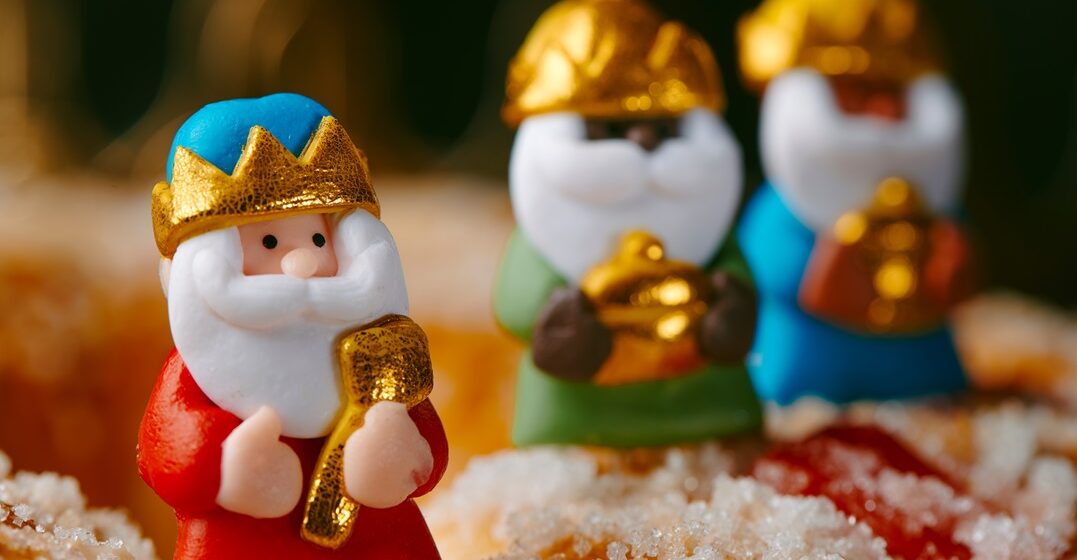Published on November 13, 2023

Three Kings’ Day: What is it and how is it celebrated?

In many Spanish-speaking countries, the festive spirit of the holiday season stretches into the early days of the New Year thanks to the beloved tradition of Three Kings’ Day (Día de los Reyes). On January 6, many families across Latin America and Spain gather once more to exchange warm embraces and share delicious treats in honor of the Epiphany.
But what’s the story behind Día de los Reyes? How did it come to be, and how is it celebrated? Let’s explore this cherished festivity together and learn more about the customs that surround it.
While many people take their Christmas decorations down on December 26, Christian families across the world happily hold on to the holiday shimmer for a few more days. That’s because they still have one more feast on their calendars: Día de los Reyes.
On January 6 — or January 19, for some Orthodox churches — Christian families and friends come together to commemorate the Epiphany. The Epiphany marks the end of the Twelve Days of Christmas and is one of the most treasured and anticipated holidays in Christianity, as it signifies the “revelation” of Jesus as God’s gift to the world.
Many countries refer to the Epiphany as Three Kings’ Day in recognition of Jesus’ manifestation to the Three Magi (also known as the Three Wise Men). And who are these Three Magi? Let’s look into it.
The origin of Día de los Reyes stems from the Gospel of Matthew, the first book of the Bible’s New Testament. It narrates the story of the Three Magi from the “East,” who witnessed the miraculous rise of a star heralding the birth of Jesus.
The Magi, in their quest to find Jesus’ place of birth, caught the attention of King Herod I of Judea, who had already heard rumors of the birth of a new king. In his jealousy, Herod asked them to disclose the exact location of Jesus’ birth once they found it, for he (deviously) wished to join in the adoration.
The Magi continued their journey to Bethlehem, guided by the glittering star. Once they reached the young child, they joyfully offered their worship along with three precious gifts: gold, frankincense and myrrh. Having accomplished their mission and been warned in a dream to not return to Herod, the Magi then returned to their own lands by a different route.
Although the Bible originally did not explicitly mention how many Magi there were or if they were, indeed, kings themselves, subsequent narrations have embellished the story. Today, the Three Magi bear the names of Caspar, Melchior and Balthasar and are colloquially represented as “kings.”
The Wise Men tradition is particularly prevalent in Catholic communities in Spanish-speaking countries. Let’s take a look at some of the most vibrant customs surrounding it.
In Spain, on January 5, streets are lined with families coming together to see the large Three Kings’ Parade.
Community members dressed up as the Magi file down the street and pour candy into the waiting hands of children. The next morning, these same children will wake up to a house filled with gifts left by the Magi during the night.
Adults join in the fun by sharing a traditional dried fruit cake called roscón de reyes (kings’ cake).
In Mexico, the celebration of this holiday arose from Spanish colonization and Catholic evangelization. Today, it’s a major tradition for Mexican families. In some households, gift-giving for children is reserved for the Magi rather than for Santa Claus.
After the Magi deliver the presents, families meet up and share a tasty dinner, which, as in Spain, includes king cake (rosca de reyes). Embedded within the cake is a plastic figurine representing the baby Jesus; whoever is “fortunate” enough to find it is tasked with presenting tamales for dinner on February 2 (Candlemas).
In Argentina, children place their shoes next to the family nativity scene, symbolizing their readiness to receive gifts on January 6. They also set up some food and glasses of water for the Magi and their camels.
Similarly, kids in Puerto Rico prepare shoeboxes filled with grass for the Magi’s faithful companions.
Now we know the story behind Three Kings’ Day, and why children especially look forward to this holiday celebration.
Up for learning some related vocabulary in Spanish? You never know, maybe knowing how to say “Happy Three Kings’ Day!” in Spanish will earn you a slice of king cake come January.
| English | Spanish |
| Three Kings’ Day | Día de los Reyes/Día de los Reyes Magos |
| Happy Three Kings’ Day | Feliz Día de Reyes |
| kings’ cake | rosca (Mexico) de reyes roscón (Spain) de reyes |
| slice | rebanada, pedazo |
| magi | magos |
| Bethlehem | Belén |
| camel | camello |
| gift | regalo |
| gold | oro |
| frankincense | incienso |
| myrrh | mirra |
| plastic figurine | monito |
Three Kings’ Day is one of the most revered traditions in Spanish-speaking countries. For many families, it’s even more significant than Christmas itself. Not only is this an exciting time for kids, but it’s also a time for families to come together and share a delicious meal.
Now that you know the background behind this cherished celebration, you can join in, too! Just make sure you know the recipe for those tamales…or scout the nearest tamale vendor, just in case!